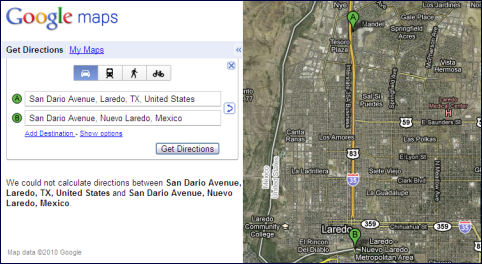No passport visa for Google Maps
It looks like crossing borders can be a problem in virtual worlds too.
We know how difficult is for Mexican people to enter in United States in violation of U.S. immigration law. According to the U.S. Border Patrol, there were 1,954 migrant deaths along the Mexico-U.S. border between 1998 and 2004. Well, it looks like that crossing the United States border is quite difficult in Google Maps too.
Try the following: go to Google Maps and click on Get Directions. Fill in A-field any place inside Laredo, in Texas. For example, try San Dario Avenue, Laredo, TX, United States — I like it… my own name! Now, fill in B-field any place in Nuevo Laredo, in Mexico. Again, try San Dario Avenue, Nuevo Laredo, Mexico.
You would expect to see a short itinerary that crosses the border. Wrong! You get the error message «We could not calculate directions between San Dario Avenue, Laredo, TX, United States and San Dario Avenue, Nuevo Laredo, Mexico.»

You can try any combination you like: select any address in United States, any town, any state; then select any address in Mexico, any town, any state. No way. It is not possible to get directions from United States to Mexico and vice versa. You cannot go from Los Angeles to Acapulco or from Boston to Mexico City.
Why is really a mistery. On the other hand, if you enter in A-field just California and in B-field Japan, you will obtain a long list of instructions. Look at the 33rd one…





















Si prega di usare Facebook solo per commenti brevi.
Per commenti più lunghi è preferibile utilizzare l'area di testo in fondo alla pagina.
Commenti Facebook